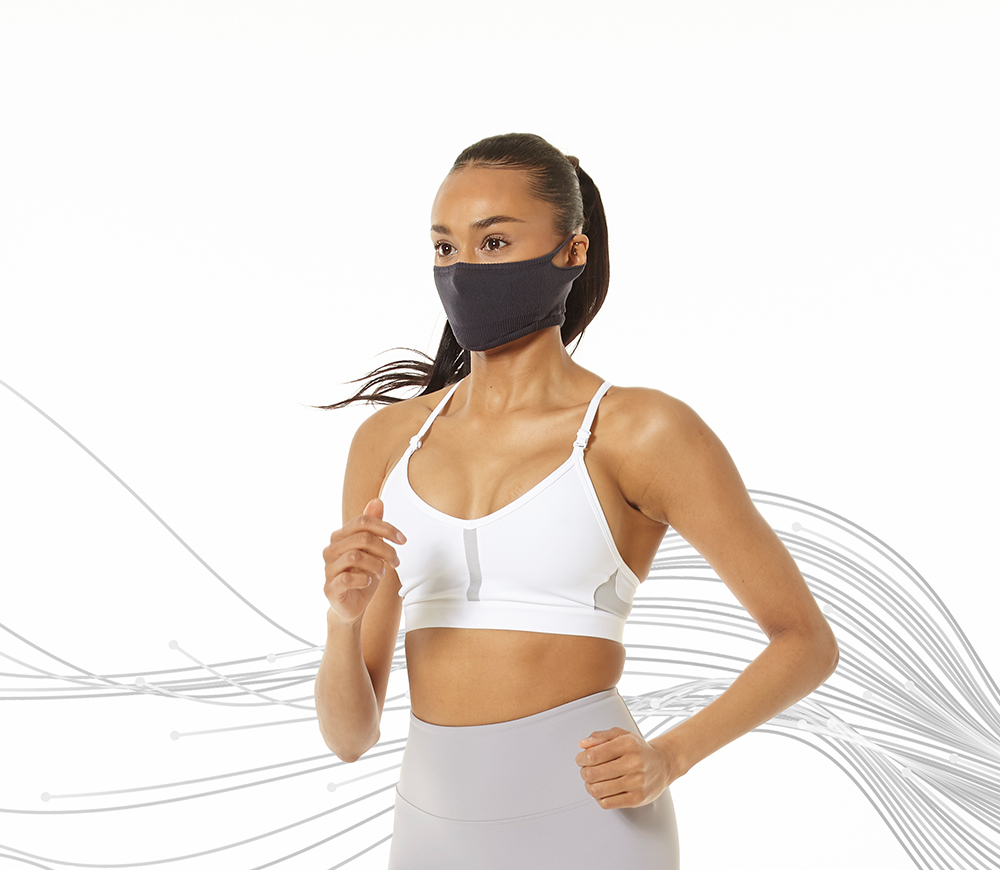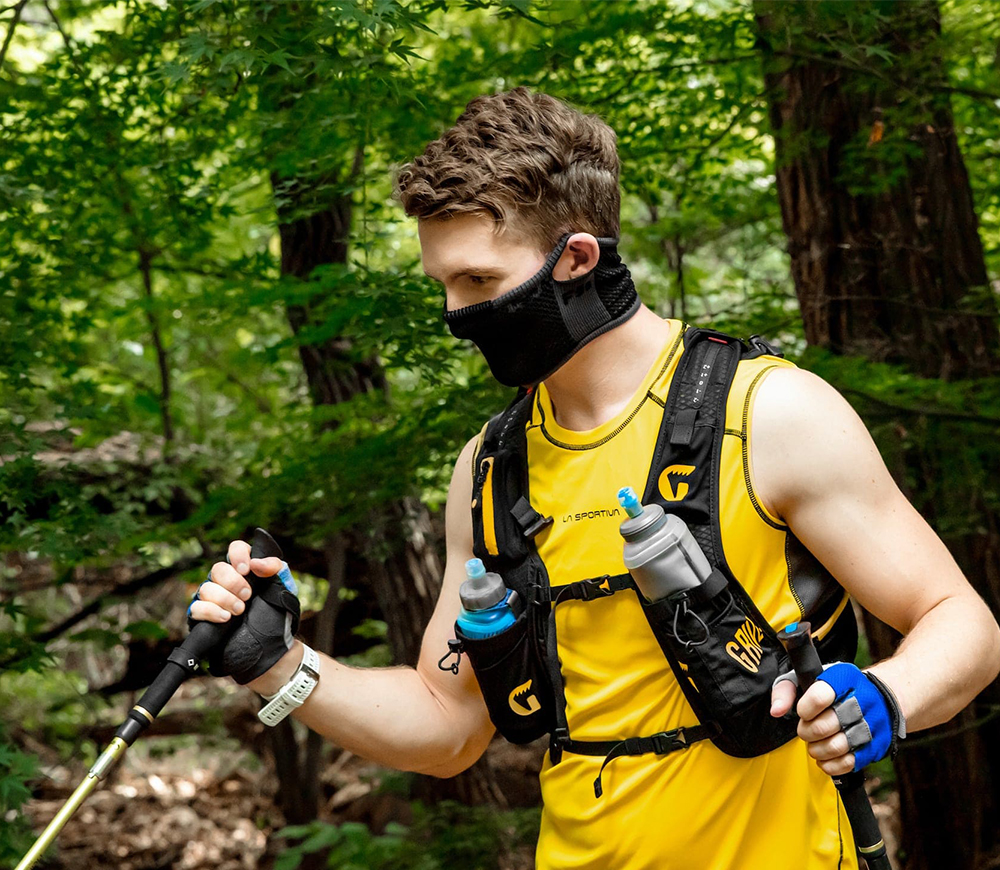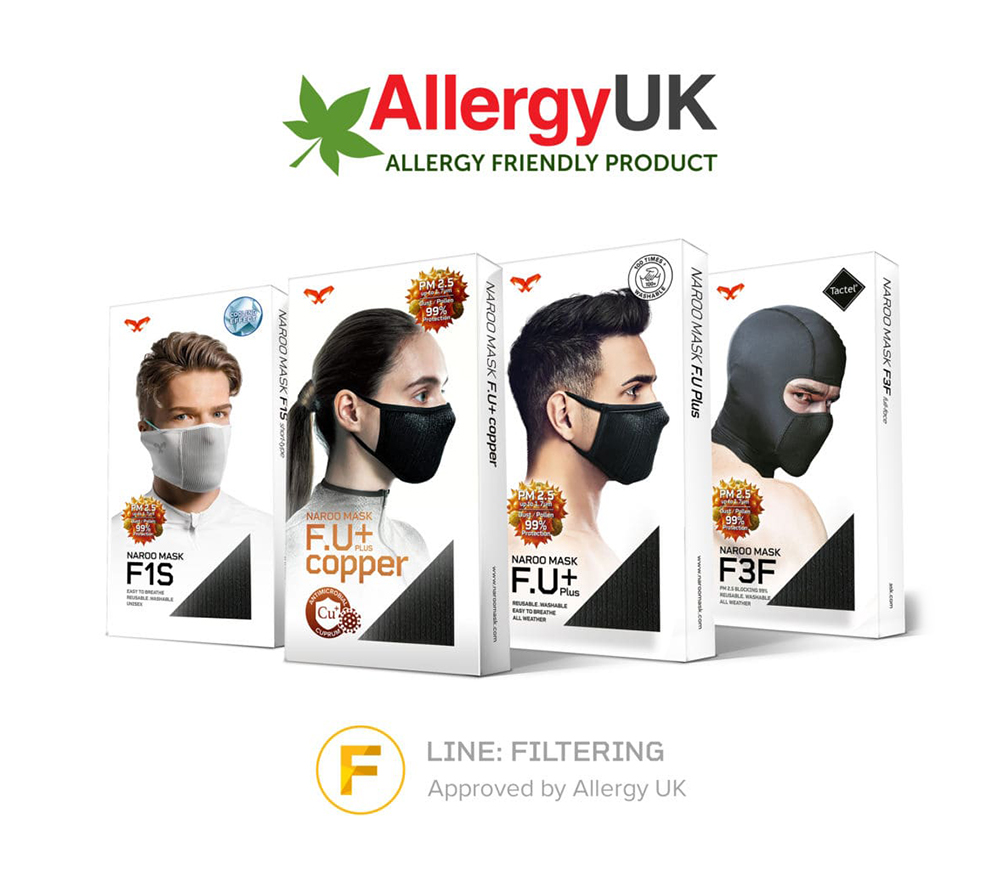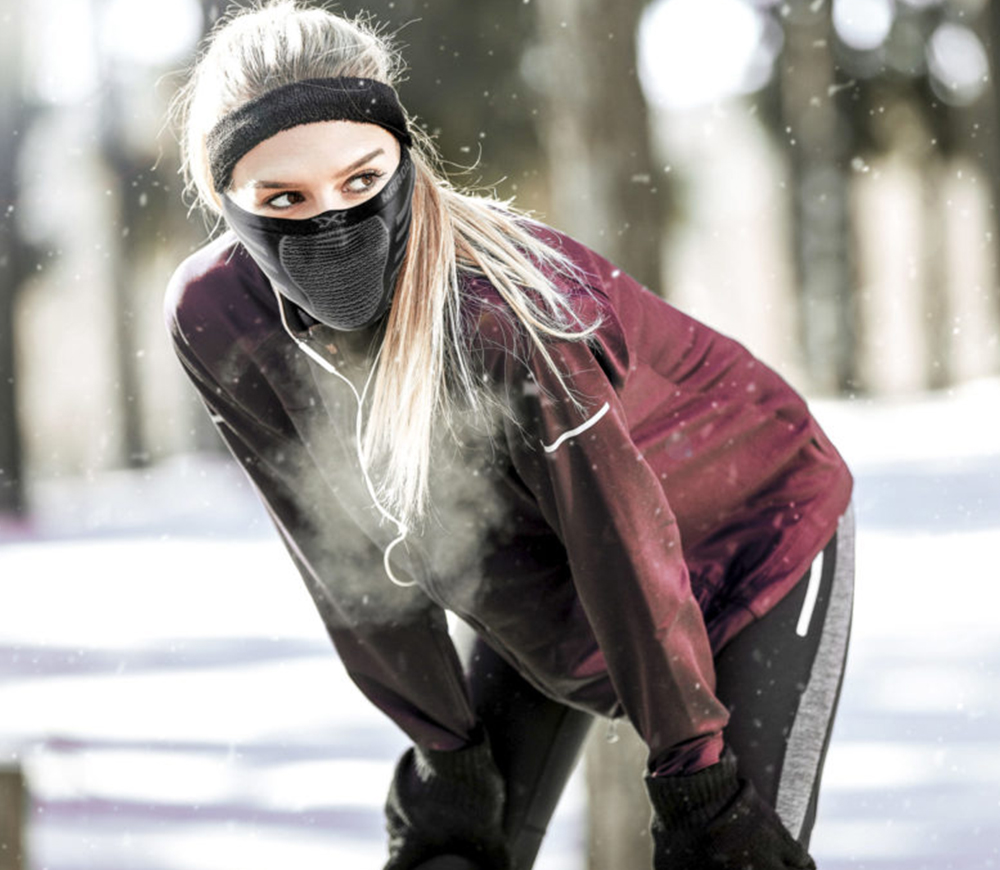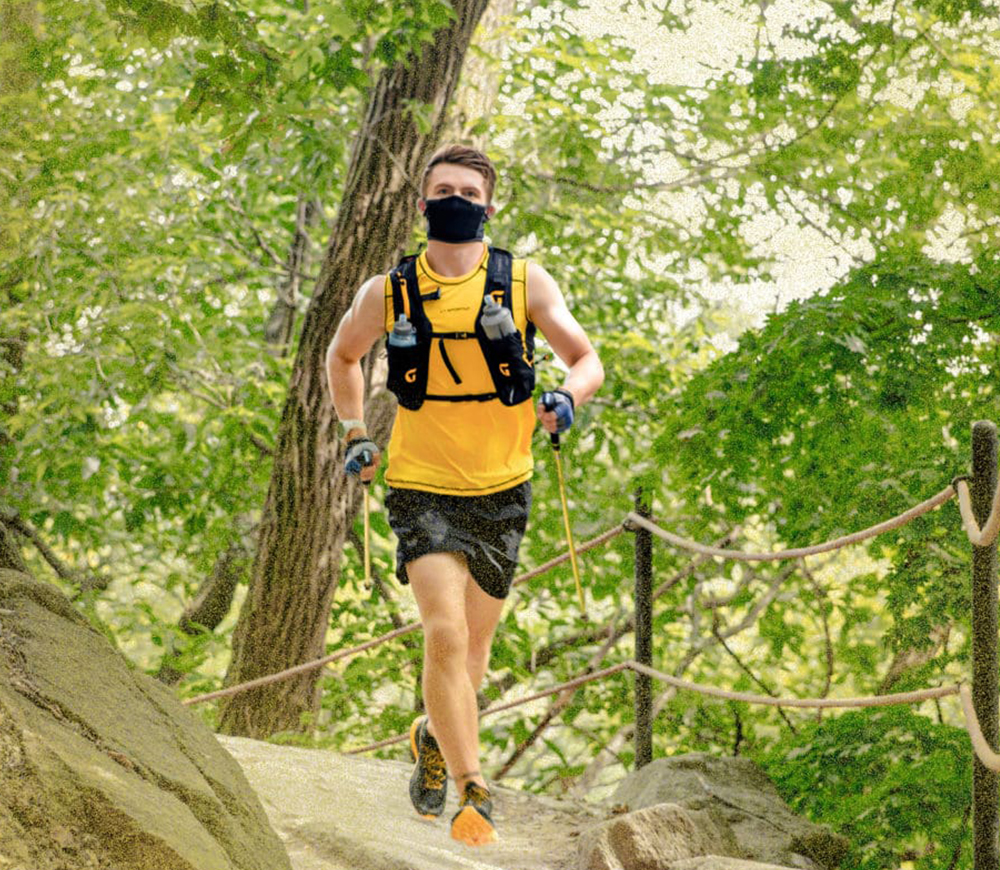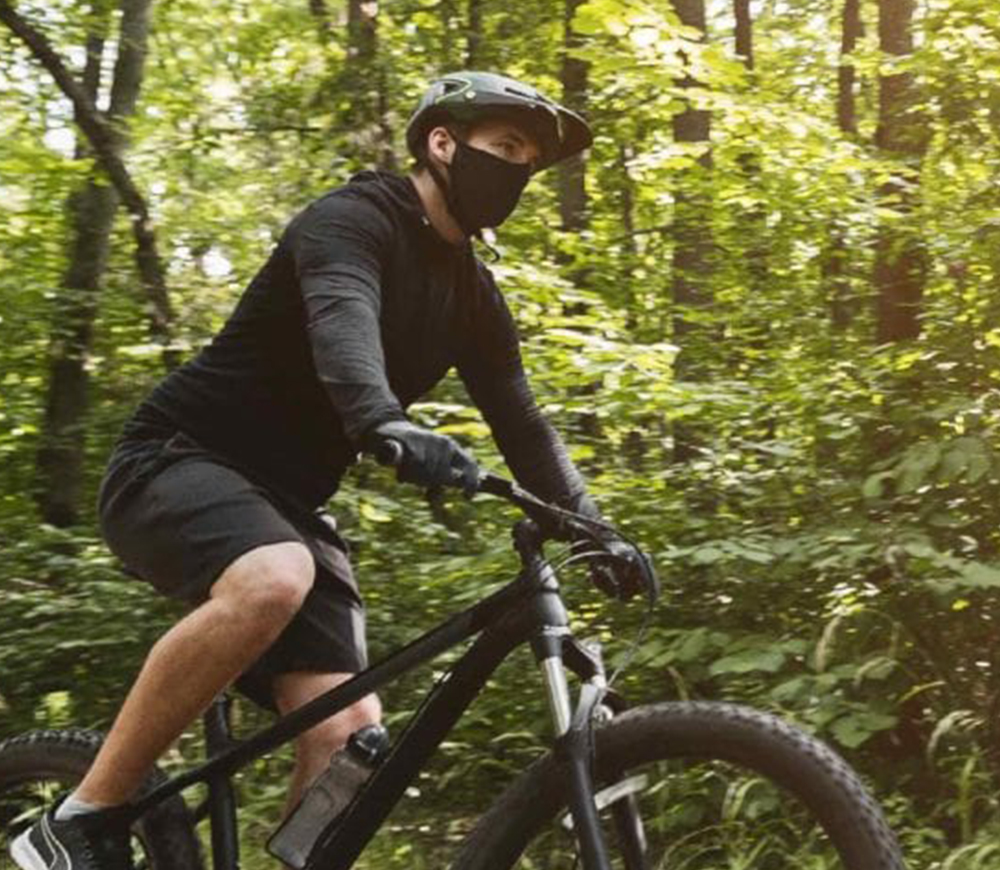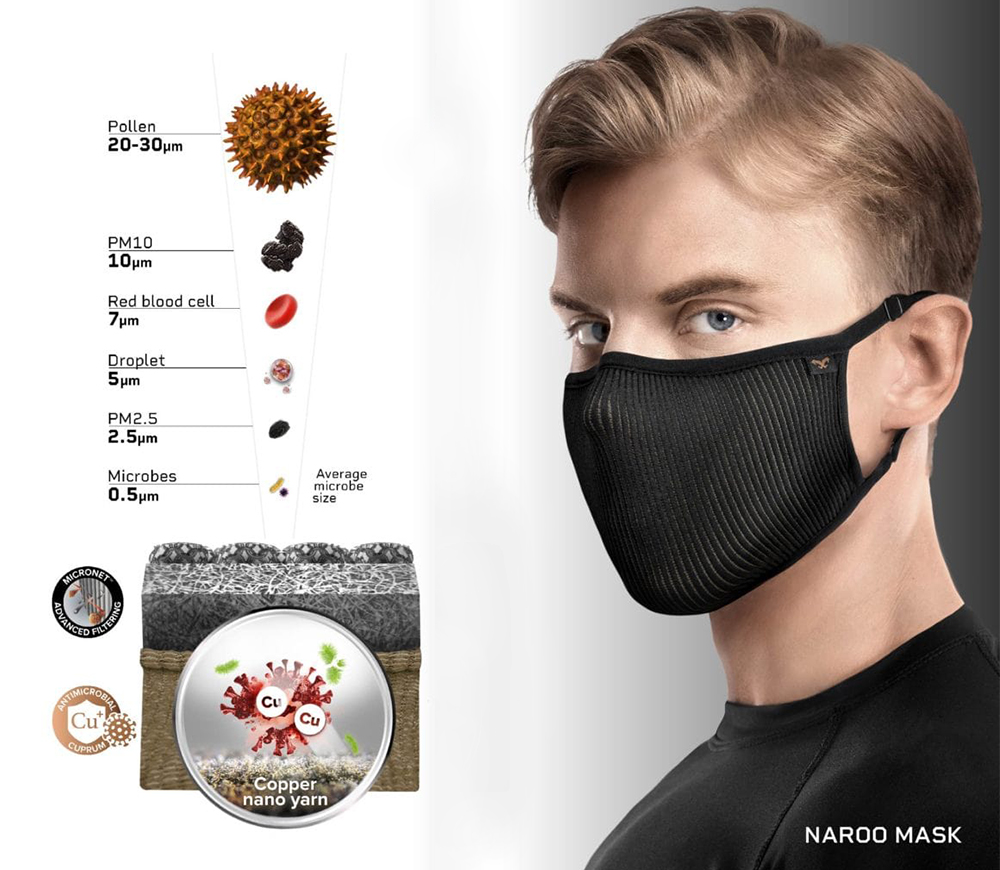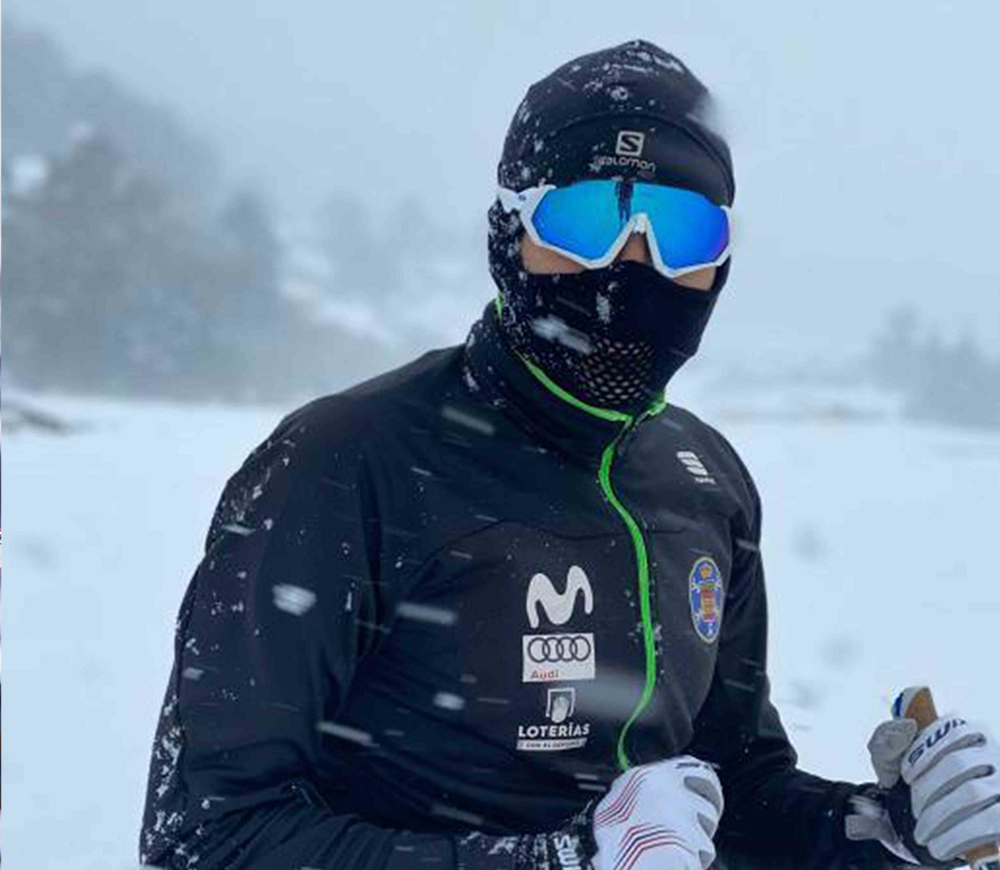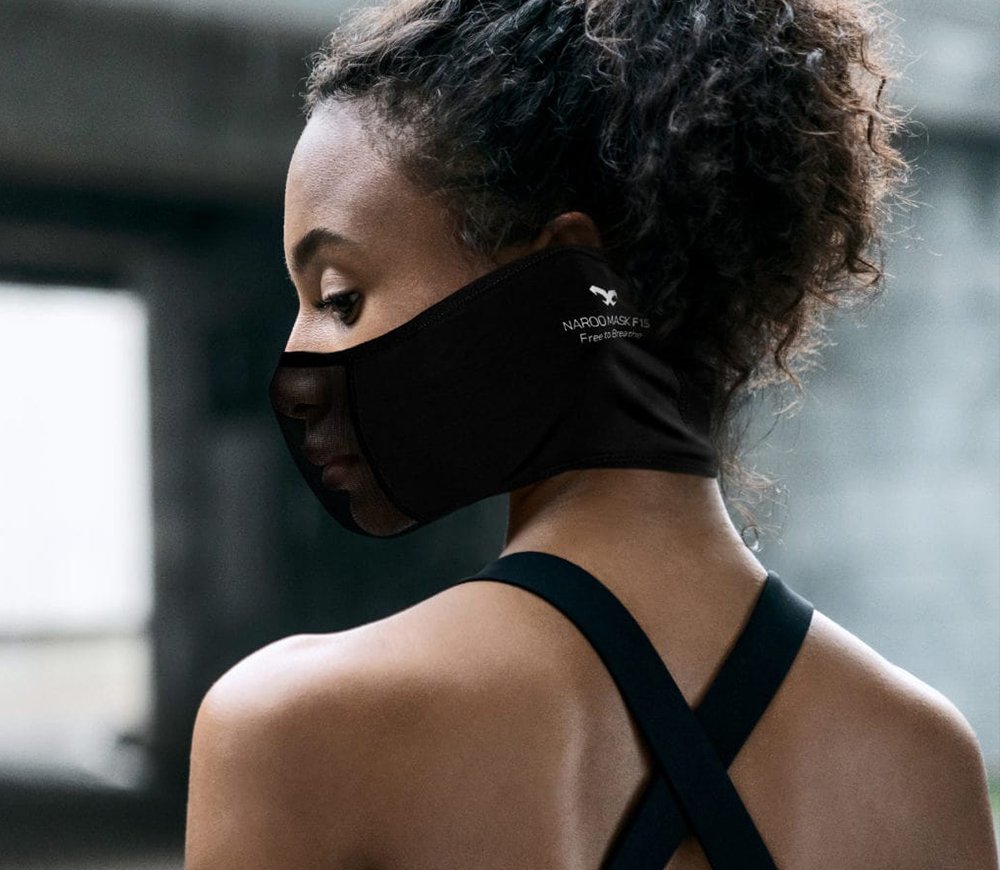Why wear a pollution mask or any type of mask? The World Health Organization (WHO) estimates that approximately one in eight deaths worldwide is attributable to air pollution. Furthermore, a Greenpeace Southeast Asia report using IQ Air data estimates the human cost of air pollution to be more than 160,000 people in the world’s five largest cities in 2020 alone.Wearing a highly effective air pollution mask is believed to reduce the risk of exposure to airborne particulates and decrease the likelihood of air pollution-related illness and death.Many believe that a replacement filter is a key component of a sports breathable pollution mask. Slipping out a filter with visible pollutants and unwanted particles can give the user satisfaction when seeing how much gunk they’ve prevented themselves from breathing in. Keeping the mental satisfaction of witnessing the pollutants aside, an effective breathable sports breathable pollution mask does not require a disposable or replacement filter. The following are some factors that make a breathing filtering mask an effective and handy product to own.Filtering AbilityWhile you do receive mental satisfaction on witnessing a disposable filter with a ton of gunk stuck on it, we don’t realize that the filter is a sign of the mask’s inability to filter out harmful particles to start with. It is only when those harmful airborne particles were able to pass through the first and external most layer of our mask that it reached the filter. The NAROO F-Series pollution masks protect the user from particles that are as tiny as 1.7 microns, which means they form a barrier against minute dust particles, pollutants, and pollen. These masks do not require the additional layer of a replacement filter because they prevent 99% of all external pollutants from entering the first layer itself. So if we were hypothetically to add a filter under a NAROO mask – it would come out primarily clean.Mask Material A typical cloth mask is usually only as safe as your cloth shirt is. Cloth is known for its breathability, its large pores that allow air to pass – and hence is a great material to make clothes out of – since they allow your skin to breathe. For the same reason, most cloth masks will contain a replacement filter to act as an additional layer of protection between the pollution mask and the user. It is not enough to wear a cloth mask by itself. Keeping this in mind, the NAROO filtering sports breathable pollution mask were engineered with fine MICRONET™ material. The latter is a special fiber built by NAROO to enhance flexibility, protection, and comfort. It single handedly protects the mask wearer from 99% of external pollutants around them without the hassle of any additional layers or filters.A NAROO filtering pollution mask protects against harmful pollutants thus safe guarding your from the following potential health conditions-Respiratory illness and infectionsStress and damage to the heart and lungsDevelopmental diseases such as asthma, bronchitis, and emphysemaShortened lifespan due to poor lung healthFit and ComfortMost masks that have individual replacement filters are not efficient sports masks because of their loose fit. A one piece mask without removable filters fits a whole lot more snugly, sealing all entry points for any possible airborne particles or pollutants.The NAROO breathable sports masks are made to take the shape of the wearer’s face so that they seal the front and the sides in a comfortable and safe manner. As designers of sports masks we also have to keep in mind the fact that our masks will be worn by athletes while they’re running, cycling, gymming, etc. Hence our filtering masks have to fit snug despite quick and intense movements.Product SustainabilityIn today’s day and age disposable replacement masks are not the most sustainable solution when it comes to pollution masks. In fact disposable filters that need to be thrown after single-use pollute the environment in large quantities.The NAROO sports filtering masks are reusable and sustainable. You can wash them gently, post a workout session, and re-use the very next time you decide to step out. They are built with durable material that leaves them as good as new after every wash. Not only is the NAROO sports mask a great way to guard yourself against air pollution, but it is also an economical, sustainable, and environmentally friendly solution that doesn’t add to waste generation.Holistic ProtectionMost of us are primarily concerned about safeguarding ourselves from the virus and similar disease causing contagions, however, unfortunately there are more factors that we need to protect ourselves from. Air pollution, pollen, harmful airborne particles – are some to name a few.NAROO breathable sports masks have been approved and certified by the notable certifiers seen on the right.They confirm that once worn correctly our masks protect both adults and children from air pollution, pollen allergies, and other body-harming pollutants. They do not require any additional replacement filter layers to block out external and injurious particles. Every NAROO sports mask provides all-rounded protection for any athlete braving the outdoors.By Aradhita Saraf (Weloquent)
A sports mask is not your everyday run-of-the-mill mask. It is specifically designed to be breathable to help sports people get the oxygen intake necessary to perform their sport.
Allergy UK – Allergy Friendly Product Award We started NAROO because we listened. We listened to the needs of sports people who were looking for ways to deal with things like pollen, pollution, and heat/cold. The more we listened, the more we resolved to become the world’s leading innovator and authority on innovative breathing solutions that support and protect your breathing. When we began in 2002, we saw that sports people needed something that didn’t exist. From start to finish, we focused not only on developing technology to address athletes’ needs, but to create product that is safe. To this day, we seek testing to ensure the quality of the product that we offer as breathing solutions. With that in mind, we are proud to announce that we are recipients of the Allergy UK Friendly Product Award for our entire filtering F-Series. Based on expert opinion, each product in the series is approved by Allergy UK as suitable for use as part of an allergen management plan and unlikely to cause a reaction. It also may be of benefit for allergy sufferers. There are an estimated 21 million people living with allergic disease in the UK. Allergy UK’s mission is “to raise the profile of allergy at all levels, with a vision for everyone affected by allergy to receive the best possible care and support.” They are the leading national patient charity for people living with all types of allergy. NAROO aligns with Allergy UK’s vision of helping people living with allergy. We want to help people with allergy continue to do head outdoors and perform their activities and sports during pollen season. Breathing is the foundation. Let NAROO help you breathe freely and perform your best. Check out our Allergy UK friendly products here.
When we think of breathing freely and the best conditions to do so, those conditions most certainly don’t include a covering over our noses or mouths. In fact, itsounds downright stifling to cover our faces during exercise. But the conditions of freezing winter can often make it necessary to cover up or be left with asthma-like symptoms and difficulty breathing – this leaves us struggling to do the outdoor activities we love. Why does exercising in cold air hurt? The lungs are made to process warm, humid air. This is how they best perform their function of intaking air, transforming it into something our bodies can use, and expelling unneeded air. When we exercise in the cold winter months, our lungs suffer because cold air may cause bronchial irritation leading to wheezing, coughing, and that painful burning feeling. Even without the increased pace of breathing during exercise, breathing during relaxed outdoor activities can be painful. But when we increase our rhythm of breathing, it can make all of these wintertime symptoms worse. You’re putting much more dry, freezing air into your lungs that are made to process warm, humid air. Also, your airways are made to humidify and warm the air as it travels through your nasal passageways and through your mouth, throat, and down into your lungs. Breathing cold air makes your respiratory system work a lot harder to warm the air and dries out your mucous membranes that help moisten the air. This can be dangerous for not only your lungs, but your other organs as they receive less air. All of these different factors create that painful burning sensation and difficulty breathing. None of these are conducive to high-performance exercise. In fact, they decrease our ability to get in a good work out. View this post on Instagram A post shared by NAROO MASK | Official (@naroomask_global) View this post on Instagram A post shared by NAROO MASK | Official (@naroomask_global) How do I exercise safely in the winter? There are several factors that can aid in safely exercising in the winter. 1. Warmth. Dress warmly. Cover your face head, neck, and body so that you will not lose body heat while you exercise. The loss of heat can lead to hypothermia which then causes many other potentially dangerous issues. 2. Cover your airways. Almost any covering will help to humidify and warm the air as you breathe. It seems paradoxical to cover your airways in order to breathe more freely. But, the science proves it. Covering your airways makes it possible for us to head outside. Although you can use almost any covering to help your lungs in the winter, many coverings make it harder to take full breaths, they are uncomfortable, and they press against your face and get into your mouth. Athletes have specific needs that include breathing comfort and the ability to draw full breaths to power their exercise with oxygen. They need sports masks designed for people who exercise. A mask like NAROO’s Z9H is a great option for athletes. Here’s what it does: Humidifies and moistens the air Covers the head, ears, face, and neck to maximize warmth, UV protection, and wind protection EX | BONE (an apparatus that creates an air warming chamber) that keeps the cloth comfortably off your nose and mouth The EX | BONE can also be used with EX | HALE to prevent goggles and glasses from fogging up A zipper to let as little or as much air and wind into the mask as you wish Prevents the mask from slipping by using a combination of elastic fabric and stitching along with a moldable nose clip. If you’re in the market for a lighter mask, the Z5H has many of the same qualities as the Z9H but isn’t quite as thick. It will also protect your airways from that horrible burning and help you enjoy your outdoor exercise. Always remember though, use your discretion. If you’re hurting, or your doctor suggests to avoid outdoor activity, please listen. But if you’re ready to head outdoors, please do consider taking NAROO with you. We’ll keep your airways covered while you enjoy your exercise. Check out the Z9H and the Z5H. Don’t let the winter paradox stop you from exercise. NAROO’s sports masks won’t hinder you. They’ll set you free.
Seasonal Allergies: 6 Tips For Sports During Hay Fever Facing Pollen Allergy Head-on In our last blog we covered the common problem of pollen allergies, which experts refer to as “hay fever,” “allergic rhinitis,” or “seasonal allergic rhinitis”. We also discussed the impact of pollen allergy on the bodies of athletes, and answered the burning question of “Can I exercise with seasonal allergies?” In this blog we’re going to delve deeper into ‘How one can mitigate allergy symptoms‘, but also ‘How face masks—and in particular NAROO’s sports masks—can keep you working out or competing outdoors without your body working against you’. Impact of hayfever on performance Nasal congestion caused by colds and hayfever can impair nasal function and affect sports performance and enjoyment. Hay fever symptoms can lead to sleep deprivation, anxiety, and increased fatigue, which can negatively impact athletic performance. However, hay fever has been shown to negatively impact sleep and mood, and can impair sports and athletic performance. Tip #1: How To Stop Pollen Allergy Symptoms? Seek Dedicated Allergy Medication Note: Please consult with your doctor before making any changes to your medication. Treating allergic symptoms with over-the-counter medication such as antihistamines and decongestants is very common. Unfortunately, navigating the effects some of them may have on the body of an athlete, as well as any potential legal complications for those competing professionally, is a stressful and lengthy process. That being said, it’s perfectly possible to find the medical solution that fits your body and needs as an athlete. Just make sure to consult with your personal physician and/or the physician of your sports medicine team if you’re a professional. Tip #2: Can pollen allergy cause difficulty breathing? Yes, So Control Your Indoor Environment As the Asthma and Allergy Foundation of America (AAFA) says, “allergy and asthma control begins at home.” While staying inside may not be an option for most athletes, improving indoor air quality can reduce your overall exposure to allergy and asthma triggers. No one likes the idea of having to face how unhygienic our home, work, or car environment can be, but tackling those spaces room by room can spare you from much allergic grief. So remember to clean thoroughly, and look at your home air purifying options. Tip #3: How to Prevent Itchy Eyes? Protect Your Eyes During Allergy Season We tend to think of pollen allergy as something that only affects our upper and lower respiratory health, but those itchy, welling eyes you get with a faceful of spring aren’t due to the season’s breathtaking beauty. Allergies—including pollen-induced allergy—affect your ocular health in some pretty nasty, unwelcome ways. As an athlete, under the guidance of your doctor, you can wear contact lenses, glasses, or goggles in order to protect your eyes, but beware of the downsides to the first, such as the increased risk of bacterial infection, irritation, and more. Tip #4: Check Pollen Count to Help Allergies Checking your area’s latest pollen count can significantly help you when you’re planning outdoor exercise. While pollen levels are usually at their highest “before dawn and in the late afternoon to early evening”, your reaction to them has many variables. It’s therefore advisable to keep track of them through a regularly updated pollen forecast. Thankfully, there are many pollen monitoring stations in the world, so you are most likely to find accurate information about the presence and quantities of pollen in your area. Tip #5: How to Avoid Pollen Allergies? A Well-Balanced Diet According to the study “Dietary Interventions in Pollen-Related Food Allergy,” “up to 90% of pollen-sensitized individuals are allergic to foods that cross-react with pollen”. After all, our dietary habits affect our health in many ways, so it stands to reason that even seasonal allergies would have their ties to them. As Sarah Garone, NDTR of Healthline advises, “from reducing inflammation to boosting the immune system, there are a number of dietary choices that may help mitigate the miseries of seasonal allergies.” You may also benefit from avoiding foods connected to the type of pollen you are most allergic to. Tip #6: Use a face mask for relief. Wear a Pollen Allergy Mask Nothing will protect your nasal cavity, and respiratory system better than face coverings, and as a new study conducted in Turkey supports, “face mask usage can be considered a preventive measure to minimize allergen exposure in high-risk environments.” When exercising outdoors and being exposed directly to irritants, a face mask is a must-have sports accessory for protecting your airways. As pollen particle sizes typically range from 9μm (microns) to 200μm, surgical masks—which filter particles as small as 3μm—are a good option, and even cloth masks can help. That being said, these specific types of masks are not very sports-friendly options for any athlete on the go. This is where sports masks that counteract allergies come into play, and where we at NAROO can help you stay active while staying pollen-free. Why NAROO Sports Masks? Unlike the typical go-to options for masks—N95 respirators, surgical, or cloth masks—NAROO’s sports masks are designed and developed for athletes. Our filtering F-Series is not only made to filter particles as small as 1.7μm, but offers more breathability, reusability, and variety than most heavy-duty options, while improving on their filtering capabilities. An athlete who needs to comfortably and safely train outdoors—be it going on a simple run, cycling, or preparing for a professional event—needs a reliable, flexible, breathable filtering mask specifically designed for rigorous activity. NAROO masks do not require a change of filter, and retain their properties even after being washed 100 times. They are a dependable, scientifically certified solution made for reducing your exposure to pollen without reducing your time outdoors. “Intended for everyday use and for amateur and professional athletics, NAROO face covers protect people on the go in environments with pollen, dust, in hot or cold weather. They are easy-breathing and filter out environmental agents that cause breathing difficulties or trigger allergy.” — AllergyUK “Both the NAROO Mask F.U+ and F.U+ Copper are masks worth considering if you are looking for a new form of pollution protection. The masks
Natural remedy for allergies: Relief that you might be missing There is nothing quite like the great outdoors in spring, and there is nothing quite like the hit that this beautiful season can inflict on the human body. As inspiring as nature may be in full bloom, pollen allergy is an all too familiar enemy of many, including athletes. As with everything in life, there is bad news and good news here; yes, pollen could definitely jeopardize or ruin your sports goals during allergy season, but there are ways to protect yourself and your performance from it apart from medication. What Are Pollen Allergies? Pollen allergy—sometimes commonly referred to as “hay fever,” “allergic rhinitis,” or as “seasonal allergic rhinitis” by experts—is an allergic reaction to the pollen produced by plants and carried around by the wind. With one in five people being affected by it at some point in their life, it is most likely you either face it yourself, or at the very least have encountered it through family, friends, or peers. In Western countries, between 10% and 30% of people are affected. Hay fever usually appears with allergy symptoms such as: Itching in your nose, roof of your mouth, throat, and eyes Sneezing Stuffy nose (congestion) Runny nose Tearing eyes Dark circles under the eyes If these—especially a combination of them—sound familiar, particularly during pollen season then you know the culprit behind them. Now, while many of these symptoms are annoying, allergic rhinitis itself can also cause a variety of other issues that can range from significant hindrances to significant dangers. For one, those who are allergic to pollen are also prone to allergic conjunctivitis (eye allergy). But it is also theorized that upper respiratory inflammation can lead to lower respiratory issues as well. According to Yale Medicine allergist Florence Ida Hsu, MD, “You’ll find people with allergies getting recurrent sinus infections, and both can lead to respiratory symptoms, asthma, and bronchitis.” While there is a lot we still do not know about allergies, we do know that seasonal allergic rhinitis “… is often hereditary as to whether or not we develop allergies, which means it can be passed down through genes from parents to their children.” We also know that climate change is making them worse in the long-term. It is therefore always advisable to consult with your physician if you think or feel you may be affected. Most common natural remedies and techniques for allergies relief Reduce your exposure to allergy triggers In other words, stay at home, but as an athlete can you stay at home all season? In other words, stay at home, but as an athlete can you stay at home all season? It is recommended that you stay indoors during the peak hours when symptoms are most likely to occur and exercise later in the day, around sunset. During this time, the amount of spores scattered is low and the wind is light, so there will be no irritants flying into your eyes, nose, or mouth. It is also effective to choose a grass-free area for exercise to avoid stirring up spores. Clearing the sinuses Rinsing the nasal passages with saline solution (nasal rinse) is a quick, inexpensive, and effective way to relieve nasal congestion. It directly washes mucus and allergens out of the nose. Saline solution can be purchased ready-made or in a kit and added to water. If using a kit or homemade saline solution, use bottled water to reduce the risk of infection. Alternative Treatments Many natural remedies have been used to treat hay fever symptoms. Treatments that may improve symptoms include extracts of the shrub Butterbur, Spirulina (a type of dried algae), and other herbal medicines. Due to the limited number of clinical trials designed, there is insufficient evidence to demonstrate the safety and efficacy of these therapies. Acupuncture has shown limited benefit potential, but research results are mixed. How Does Pollen Affect Us As Outdoor Lovers? According to several studies, allergic rhinitis is more common in athletes than previously thought, with endurance athletes in particular having a high prevalence of it (44% of athletes). When you breathe harder and longer—which is common when exercising or competing as an athlete—you inhale a larger amount of allergens and irritants over a longer period of time. According to Katelaris et al., 2000, allergic rhinitis impairs physical performance in professional athletes by affecting sleep, decreasing the ability to concentrate or reducing physical fitness. The same study also concluded that athletes are more prone to asthma. In the survey of 214 athletes representing 12 Olympic sports, 21% reported having experienced asthma. All is not bleak, however. If you are now wondering “Can I exercise with seasonal allergies?” The answer is absolutely, YES. You simply have to exercise more cautious than others. There are many ways to reduce the health risks and comfort issues brought by pollen allergy. The tricky part is choosing—and balancing—between prevention and treatment. As Medical News Today states, “medical treatments, home remedies, and changes in some lifestyle habits can help ease symptoms of pollen allergy.” At the same time, it’s impossible to be completely free of them through treatment alone. It is necessary for you to also consider how to avoid exposure to these allergens in the first place. Staying indoors and fortifying your home environment does help, but an athlete needs that safety and comfort level on the go. Natural remedy for allergies: Wear your face mask for relief So if you need a face covering to tackle pollen head on, what is the best allergy mask to go for? Well, for one, any reduction in exposure is better than full exposure. According to a study by the Nippon Medical School in Tokyo, Japan, standard non-woven fabric surgical facemasks and glasses with side guard protection can help to a degree, but they cannot go up against wind speed and direction. N95 respirators do a better job at filtering pollen particles out, but they are some of the least comfortable, least breathable to exercise or compete with.
Do Pollution Air Masks Cause Breathing Problems? If you live in a place with high air pollution levels, you’re probably familiar with all of the ways to cope with this major public health issue. You can invest in an air purifier, clean regularly, stay inside, and wear a mask if you have to go out. But if you’re an athlete or a person who likes the outdoors, staying inside can keep you from doing what you love. So what is the solution for athletes and people who like to enjoy the outdoors? Before we get to that, let’s take a look at the common concerns of people who live in places with high pollution. Concerns about wearing pollution air masks One of the biggest worries people have about wearing a pollution air mask is that we won’t be able to breathe. The thought of covering our noses and mouths seems like it may be uncomfortable or cause shortness of breath. Dr. Evelyn Lewin and many other doctors have done research that addresses our concerns. In an article she published in October 2020 she explains that face masks don’t affect gas exchange, which basically means we still get the air we need while wearing a mask. This is good news. However, that doesn’t make them any easier to wear. This is not so good news. In hot weather, they can get too hot. In the cold weather, the moisture from your breath can freeze, making the mask uncomfortable and less effective. They are sealed on all sides of the face, which can make you feel smothered. Or alternatively, improperly sealed masks can send warm air up into your eyes. In general, they just seem quite uncomfortable and not worth wearing despite heavy pollution. What the experts say about wearing pollution air masks Our worries about wearing masks are real concerns. These concerns inspired doctors and research experts all over the world to research and explain how wearing masks can affect our breathing and our lives. Even though doctors have found that masks allow us to get the air we need, they are still uncomfortable, which can cause us anxiety. Canada-based lung specialist Christpher Ewing tells us that when we feel discomfort, the way we breathe can change. He says that it is important to give ourselves time to get used to wearing pollution air masks. It’s like taking time to get used to a new pair of glasses. How do pollution masks work? Pollution masks can stop pollution from entering your lungs and affecting your entire body in several ways. Fabric choice: Different kinds of fabrics can filter pollutants with varying effectiveness. Most pollution masks use a combination of fabrics to create an effective filter. Fabric thickness and layering: The thicker the fabric, the more effective the filter. Combined with layering of fabrics, this makes for an effective mask. Stitching choice: Pollution masks should be tightly stitched or else they are not effective at all. The choice of stitching is key to a good pollution mask. Mask fit: How a mask fits may be the single most crucial aspect of a pollution mask. If it does not seal tightly to your face, pollution can get in. A good pollution mask creates a seal from your nose, to your cheeks, to your chin. No unfiltered air should get in. Copper: Some masks have begun to include copper as a filtration aid as it has native antimicrobial properties, making the masks not only effective against pollution, but bacteria as well. Using the methods above, an effective pollution mask should filter pollutants of at least 2.5 microns in size in order to truly be an anti-pollution mask. But can pollution masks really protect us as athletes? Short answer: Yes. The longer answer is dependent on if the mask is well constructed and even better fitted. Tight stitching is paramount as well as the layering of the fabric. If the mask doesn’t fit properly, it is essentially useless against pollution. Masks should also be tested by accredited third party institutions to be sure that they can filter pollutants at least as small as 2.5 microns in size. That is the size of many of the most harmful particles that need to be functionally trapped by a good pollution mask. If they can, then you have found a good pollution mask. A key point in a pollution mask for an athlete is comfort. This is also protection as an uncomfortable mask we don’t want to wear is not protection at all. A good mask for our outdoor adventures needs to be comfortable. What does NAROO have to do with it? NAROO knows what athletes need: a breathable, functional pollution mask that will let them exercise safely. With that in mind, we created the F Series, which is a set of filtering masks that address the concerns of mask wearers, and of sports people wanting to head outdoors. Are the masks breathable? Yes. This is the one quality that sets this line apart from other pollution masks and makes it especially suited for sports people. Our masks are easy to breathe in. Do they have testing certifications? Yes, we have certifications proving their effectiveness as pollution masks. Do they create a seal? The masks seal against the face and shield it from pollutants. The bendable nose wire allows it to fit to the nose and under eye area snugly while the stitching of the knit fabric hugs the cheeks and chin to seal it. What size particles do they filter? They filter particles as small as 1.7 microns, catching not only normal pollutants but ultrafine particles. Do they use tight stitching? Our masks are made with a special knit that allow them to be both breathable and stitched tightly enough to catch pollutants. What about discomfort in the heat and the cold? The F Series have many different masks that are suited for use in hot and cold weather. Moisture-wicking fabric allows for any perspiration or condensation
Say goodbye to uncomfortable moisture this winter!Dashing through the snow, on a pair of super skis~Down the hills we go, huffing all the way~Condensation forms, soaking all our masks~What a horrible time to ski and feel cold moisture on our necks!Oh! Soggy masks. Soggy masks!As we venture into the colder months of the year, we have the snow and winter sports to look forward to. But, we also have the problems that come with trying to stay warm as we enjoy the cold. One of the biggest ones is the one described in our holiday time play on “Jingle Bells,” “Soggy Masks.” We know we have to keep our airways warm so that we can breathe and exercise properly. We put scarves and masks and gaitors and neck warmers on to try and tackle these problems, but we’re normally left with wetness around our mouths, noses, cheeks, necks, and sometimes even ears and heads!Our wintertime and holiday time solution to avoid the most uncomfortable situation when exercising in cold weather is to wear something specifically designed to tackle our wintertime woes: a good winter mask.That’s where NAROO steps in. We plan, test, and design our masks to take care of athlete’s safety and comfort. Wearing wet clothes in freezing temperatures stresses not just our minds but harms our bodies as well, causing us discomfort and potentially weeks of colds and recovering with tea and blankets afterwards. Tea and blankets are nice, but not when we could be outdoors!We design our masks with moisture-wicking fabric. In laymen’s terms, that means that the fabric is quick dry. The condensation from our humid breathing and sweat is absorbed by the first layer of the mask, and then moved through to the top layer for a quick evaporation process, keeping us nice and dry. We should be mindful of the most important features of masks needed to exercise in winter: Insulating – it keeps us warmEasy breathing – we won’t struggle to breatheQuick dry – moisture quickly evaporatesWashable – good for many usesComfortable – pairs nicely with wintertime gear like helmets, googles, and hatsDoes not slip – the mask stays in place with customizable fabric and bendable partsProtects against UV radiation – protects UV glare from snow or directly from the sunMoisture-wicking fabric – fabric made to enable the quick dry to keep you dry as you goNOT absorbing – moisture is not absorbed, it is quickly evaporated A mask needs to be washable for serious sportspeople who want to be up the mountain or outdoors every day. We’re not just one-day skiers, snowboarders, and athletes – if we do winter sports, we do it seriously. As we sweat, it’s important to pay attention to hygiene, to avoid unpleasant odors, and avoid feeling sticky. NAROO’s moisture-wicking fabric moves moisture from your skin to the surface of the mask so it can evaporate. Wash your mask, and wear it the next day, and it will give you the same comfortable and easy breathing features, just like yesterday and the day before. Amazingly, our masks can be washed hundreds of times and retain the same filtering, moisture-wicking qualities as the first time worn.So grab a great wintertime mask and head out to enjoy the wintertime and your favorite sports.Take a look out our products, developed to keep you dry and happy this winter.
In the high heat of summer, the number one concern on most people’s minds is staying cool. When you’re an athlete, especially one whose sports relies on heading outdoors, it requires a bit more preparation to ensure that you stay safe. Let’s take a look at how to stay safe in the heat and how a face gaiter can help. But first, what can happen if you unsafely exercise in the heat? Heat Illness There are a number of different heat-caused illnesses that can strike if you’re not prepared. When you are under hydrated, exposed to too many UV rays, stress your body by working in the heat, and constantly out in the sun, you may be vulnerable to a heat sickness such as “heat illness.” According to the Centers for Disease Control and Prevention, these symptoms can be heavy sweating, cold pale clammy skin, fast weak pulse, nausea or vomiting, muscle cramps, tiredness weakness, dizziness, and/or headache. Doesn’t sound fun, right? Definitely not. So how can we prevent these symptoms? Preventing Heat Illness During Sports There are several key points in preventing a heat illness while practicing sports. Hydration: This is key during any time of year and in any weather conditions. But during the summer when your body sweats more to cool itself, your water intake should increase to help your body’s natural cooling system. Stop frequently for water. Dehydration can increase the strain on your heart and temperature regulating systems, which in turn decrease your ability to perform at your best. Add a pinch of sea salt into your water bottle to regain lost electrolytes as well. Shade: As much as we want to power our way through the sun and the heat, a key to exercising in summer is to be sure that we rest and get enough shade. Our bodies need the chance to cool and acclimate to the heat. Do shorter bursts of aerobic activity and take frequent shady, water breaks. Exercising in the morning or evening, when the sun isn’t as high and the UV rays aren’t as powerful can also help you stay safe and perform at the top of your game. Also, UV rays can cause skin damage. Avoiding the strongest rays will keep your skin safer. Acclimatize: This is just a fancy word for letting your body get used to working out in the heat. Start with shorter training sessions and work your way up to longer ones as your body gets used to the heat, the sun’s rays, and often, the humidity. Humidity can stifle your body’s ability to self-cool because of a decrease in the evaporation of sweat. Awareness: Know your body and its signs. Keep track of how you’re feeling, how your body is responding, and don’t push it beyond its limits. To perform at your best, you need to give your body what it needs, including rest, shade, and hydration. How to Wear Face Gaiters in the Heat Wearing a face gaiter in the heat is possible and can be safe. In order to be so, the face gaiter has to have several key points to make sure you are comfortable and can perform at your best. Breathable fabric: A mask worn in the summer needs to have breathable fabric that allows the most intake of oxygen possible so you can power your body with the fuel it needs. NAROO’s F1S is made of MICRONET™, a nylon blend with an exclusive knit that is breathable and comfortable against the skin. The reverse side of the F1S has a SPAN MESH fabric that allows for clear, unrestricted and unfiltered airflow. Washable: Unwashed masks can retain sweat, salt, and other particles that can make a second, unwashed use of the mask less effective. Washing masks between every use is paramount. The F1S can be washed over 100 times without losing its effectiveness. Cooling: Moisture-wicking water-repellent fabric will help the mask disperse sweat and condensation from the nose and mouth and keep you dry (soggy masks are no fun!) and cool. It will help sweat evaporate in humidity. UV Protection: A face full of sun lotion can be sticky and drippy, so a mask can be an alternative to UV protection without the creams. The F1S’s SPAN MESH will keep your skin safe from the sun, and as an added bonus, also from wayward insects. F1S Bonus: MICRONET™ fabric technology also filters harmful particles as small as 1.7 microns in size, protecting you from pollen, pollution, and other harmful particles. A few extra tips are to choose a lighter color mask (the F1S in white) to reflect the sun’s rays and keep you cooler, and to follow local heat safety guidelines. Shop our mask selection to choose the best summer time mask for you.

